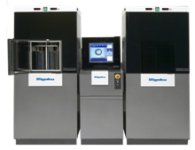*Now available to users outside the University of Minnesota and the Mayo Clinic*
The Nanoliter Crystallization Facility at the University of Minnesota is a joint effort of the University of Minnesota and the Mayo Clinic funded in part by a grant from the state of Minnesota and the NIH. The purpose of this facility is to aid researchers at these institutions by providing access to a high throughput, low sample volume, crystallization facility which will in turn increase access to x-ray crystallography and the determination of 3D atomic structures of biological macromolecules. These structures open the door to designing new drugs to block or control activity of proteins to fight disease. The structure of a protein is like the blueprint of the molecule and can be the most valuable piece of information about it. From the structure we can see how the molecule functions and how that function can be modulated or blocked to ameliorate disease. The most powerful technique for structural analysis shines x-rays on crystals of the macromolecules to determine the structure. The crystals required for this analysis are very difficult to produce. For this crystallization process to be efficient we need the reproducibility and ability to work 24/7 afforded by robotics such as the facility's Rigaku CrystalMation system (shown below).
The facility is currently used by forty-four groups at the UMN and the Mayo Clinic that require a high throughput, low sample volume, crystallization facility. The various research projects target such diverse public health problems as Alzheimer’s disease, bioterrorism, bacterial pathogens, blood clotting, bone development, calcium homeostasis, cancer, chronic pain, contraception, diabetes, hemochromatosis, HIV, Huntington disease, mitochondrial disorders, muscular dystrophy, obesity, oxalate stones and SARS.
 |
 |
 |